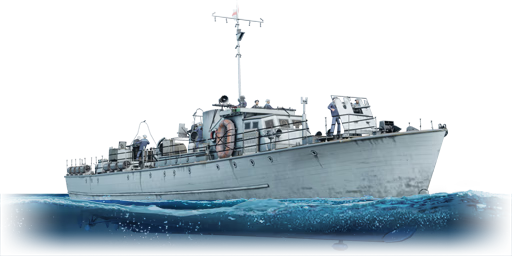

Coastal Fleet
Fairmile B (ML345)
II
Rank
AB
2.0
RB
2.0
Battle rating
Great Britain
Research country
Boat
Main role
9,200

Research
16,000

Purchase
General information
Specification
Armour
Hull
28 mm (wood)
Superstructure
15 mm (wood)
Number of sections
4
Displacement
65 t
Crew
18 persons
Max speed
Forward
37325037 km/h
Backward
14121914 km/h
Primary armament
3 pdr QF Hotchkiss cannon
Ammunition
300 rounds
Reload
basic crew → aces
2.6 → 2 s
Vertical guidance
-10 / 70°
Turret Rotation Speed
Horizontal
40344034 °/s
Vertical
2521.32521.3 °/s
| Ammunition | Type | Armor penetration (mm) at a distance: | |||||
|---|---|---|---|---|---|---|---|
| 100 m | 1000 m | 2000 m | 3000 m | 4000 m | 5000 m | ||
| HE | 4 | 4 | 4 | 4 | 4 | 4 | |
Secondary armament
2 × 20 mm/70 Oerlikon Mark V autocannon
Ammunition
3,600 rounds
Belt capacity
60 rounds
Reload
basic crew → aces
10.4 → 8 s
Fire rate
450 shots/min
Vertical guidance
-4 / 62°
Turret Rotation Speed
Horizontal
60516051 °/s
Vertical
5042.55042.5 °/s
| Belt | Belt filling | Armor penetration (mm) at a distance: | |||||
|---|---|---|---|---|---|---|---|
| 10 m | 100 m | 500 m | 1000 m | 1500 m | 2000 m | ||
| HEF-T/HEF-I/AP-T | 34 | 32 | 26 | 21 | 18 | 16 | |
| AP-T/AP-T/AP-T/HEF-I | 34 | 32 | 26 | 21 | 18 | 16 | |
| HEF-T/HEF-I/AP-T/HEF-I | 34 | 32 | 26 | 21 | 18 | 16 | |
20 mm/70 Oerlikon Mk.II autocannon
Ammunition
1,800 rounds
Belt capacity
60 rounds
Reload
basic crew → aces
5.2 → 4 s
Fire rate
450 shots/min
Vertical guidance
-5 / 60°
Turret Rotation Speed
Horizontal
7563.87563.8 °/s
Vertical
6555.36555.3 °/s
| Belt | Belt filling | Armor penetration (mm) at a distance: | |||||
|---|---|---|---|---|---|---|---|
| 10 m | 100 m | 500 m | 1000 m | 1500 m | 2000 m | ||
| HEF-T/HEF-I/AP-T | 34 | 32 | 26 | 21 | 18 | 16 | |
| AP-T/AP-T/AP-T/HEF-I | 34 | 32 | 26 | 21 | 18 | 16 | |
| HEF-T/HEF-I/AP-T/HEF-I | 34 | 32 | 26 | 21 | 18 | 16 | |
Anti-aircraft armament
2 × Turret — 2 × 7.72 mm Lewis machine gun, pattern 1916
Ammunition
7,760 rounds
Belt capacity
97 rounds
Reload
basic crew → aces
18.2 → 14 s
Fire rate
550 shots/min
Vertical guidance
-5 / 50°
Turret Rotation Speed
Horizontal
7563.87563.8 °/s
Vertical
7563.87563.8 °/s
| Belt | Belt filling | Armor penetration (mm) at a distance: | |||||
|---|---|---|---|---|---|---|---|
| 10 m | 100 m | 500 m | 1000 m | 1500 m | 2000 m | ||
| AP/T | 10 | 9 | 8 | 7 | 6 | 5 | |
Additional armament
Setup 1
14 × Mk.VII depth charge
Setup 2
6 × Y-gun Mk.VII depth charge
Setup 3
6 × Y-gun Mk.VII depth charge
14 × Mk.VII depth charge
14 × Mk.VII depth charge
Setup 4
8 × 1123/1323 lbs Type M Mark I moored contact mine
Economy
Repair cost
Basic → Reference
AB
573 → 735 

RB
820 → 1,052 

Crew training
4,500 

Experts
16,000 

Aces
180 

Research Aces
190,000 

Reward multiplier
AB / RB
50 / 60 % 

118 % 

Total cost of modifications
8,450 

9,530 

Talisman cost
640 

Research order:
Seakeeping |
|---|
Unsinkability | |
|---|---|
Firepower | ||
|---|---|---|
Rating by players
You must play more than 3 battles for the last week and more than 10 battles in a vehicle to rate it.
Like:
2
Armor protection:
Not enough ratings
Survivability:
Not enough ratings
Mobility:
Not enough ratings
Armament:
Not enough ratings
Balance:
Not enough ratings
Tips & Tricks
This space is currently empty
Do you know any interesting vehicle features?
Loading...
No articles about this vehicle yet
Become the first author and get rewards!
Write a guide, tell about interesting historical facts, make a tutorial or simply an interesting post.
No more content